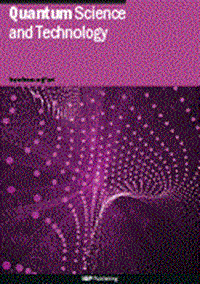Digital quantum simulation of cavity quantum electrodynamics: insights from superconducting and trapped ion quantum testbeds
IF 5
2区 物理与天体物理
Q1 PHYSICS, MULTIDISCIPLINARY
引用次数: 0
Abstract
We explore the potential for hybrid development of quantum hardware where currently available quantum computers simulate open cavity quantum electrodynamical (CQED) systems for applications in optical quantum communication, simulation and computing. Our simulations make use of a recent quantum algorithm that maps the dynamics of a singly excited open Tavis–Cummings model containing N atoms coupled to a lossy cavity. We report the results of executing this algorithm on two noisy intermediate-scale quantum computers: a superconducting processor and a trapped ion processor, to simulate the population dynamics of an open CQED system featuring N = 3 atoms. By applying technology-specific transpilation and error mitigation techniques, we minimize the impact of gate errors, noise, and decoherence in each hardware platform, obtaining results which agree closely with the exact solution of the system. These results can be used as a recipe for efficient and platform-specific quantum simulation of cavity–emitter systems on contemporary and future quantum computers.腔量子电动力学的数字量子模拟:来自超导和捕获离子量子试验台的见解
我们探索了量子硬件混合发展的潜力,目前可用的量子计算机模拟开腔量子电动力学(CQED)系统,用于光量子通信,模拟和计算。我们的模拟使用了一种最新的量子算法,该算法映射了包含N个原子耦合到损耗腔的单激发开放Tavis-Cummings模型的动力学。我们报告了在两台嘈杂的中等规模量子计算机上执行该算法的结果:超导处理器和捕获离子处理器,以模拟具有N = 3原子的开放CQED系统的种群动力学。通过应用特定技术的平移和误差缓解技术,我们最大限度地减少了每个硬件平台的门误差、噪声和退相干的影响,得到的结果与系统的精确解非常吻合。这些结果可以作为当代和未来量子计算机上腔-发射器系统的高效和平台特定量子模拟的配方。
本文章由计算机程序翻译,如有差异,请以英文原文为准。
求助全文
约1分钟内获得全文
求助全文
来源期刊

Quantum Science and Technology
Materials Science-Materials Science (miscellaneous)
CiteScore
11.20
自引率
3.00%
发文量
133
期刊介绍:
Driven by advances in technology and experimental capability, the last decade has seen the emergence of quantum technology: a new praxis for controlling the quantum world. It is now possible to engineer complex, multi-component systems that merge the once distinct fields of quantum optics and condensed matter physics.
Quantum Science and Technology is a new multidisciplinary, electronic-only journal, devoted to publishing research of the highest quality and impact covering theoretical and experimental advances in the fundamental science and application of all quantum-enabled technologies.
 求助内容:
求助内容: 应助结果提醒方式:
应助结果提醒方式:


